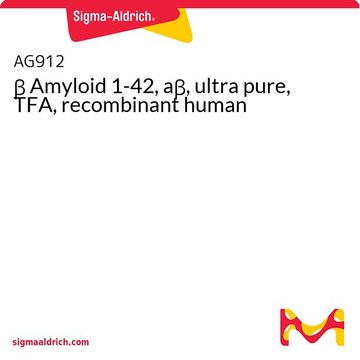All Photos(1)
About This Item
Empirical Formula (Hill Notation):
C203H311N55O60S
CAS Number:
Molecular Weight:
4514.04
MDL number:
UNSPSC Code:
12352202
NACRES:
NA.32
Recommended Products
Amino Acid Sequence
Asp-Ala-Glu-Phe-Arg-His-Asp-Ser-Gly-Tyr-Glu-Val-His-His-Gln-Lys-Leu-Val-Phe-Phe-Ala-Glu-Asp-Val-Gly-Ser-Asn-Lys-Gly-Ala-Ile-Ile-Gly-Leu-Met-Val-Gly-Gly-Val-Val-Ile-Ala
General description
Amyloid β Protein is produced from amyloid-β precursor protein (APP). It consists of two C terminal variants, such as a long tailed Aβ 1-42 and a short tailed Aβ 1-40. APP is located on human chromosome 21q21.3.
Application
Amyloid β Protein Fragment 1-42 has been used:
- for the preparation of Aβ 1-42 oligomer
- for western blot analysis
- for the interference test of immunomagnetic reduction (IMR) plasma Aβ42 assay
- to study the effects of resveratrol on Aβ 1-42-induced impairment of spatial learning, memory and synaptic plasticity
- to investigate the effect of Aβ in epithelial cell culture
Biochem/physiol Actions
Amyloid β Protein Fragment 1-42 (Aβ 1-42) has antioxidant and neuroprotective properties. Accumulation of amyloid β Protein is associated with Alzheimer′s disease (AD) and Down Syndrome. Aβ 1-42 regulates cholesterol transport and may function as a transcription factor. It may possess anti-inflammatory and antimicrobial properties.
The predominant fragment of amyloid β-protein found in the brains of patients with Alzheimer′s disease and Down′s syndrome.
related product
Product No.
Description
Pricing
Storage Class Code
11 - Combustible Solids
WGK
WGK 3
Flash Point(F)
Not applicable
Flash Point(C)
Not applicable
Certificates of Analysis (COA)
Search for Certificates of Analysis (COA) by entering the products Lot/Batch Number. Lot and Batch Numbers can be found on a product’s label following the words ‘Lot’ or ‘Batch’.
Already Own This Product?
Find documentation for the products that you have recently purchased in the Document Library.
Customers Also Viewed
Resveratrol ameliorates spatial learning memory impairment induced by Abeta1-42 in rats
Wang R, et al.
Neuroscience, 344, 39-47 (2017)
Alzheimer's disease and the amyloid-beta peptide
Murphy MP and LeVine III H
Journal of Alzheimer'S Disease, 19(1), 311-323 (2010)
Molecular genetics of Alzheimer disease amyloid.
Tanzi RE, et al
The Journal of biological chemistry, 266(31), 20579-20582 (1991)
Jeremy D Baker et al.
PLoS biology, 15(6), e2001336-e2001336 (2017-06-28)
The accumulation of amyloidogenic proteins is a pathological hallmark of neurodegenerative disorders. The aberrant accumulation of the microtubule associating protein tau (MAPT, tau) into toxic oligomers and amyloid deposits is a primary pathology in tauopathies, the most common of which
Kyunghee Byun et al.
PloS one, 7(5), e37917-e37917 (2012-06-05)
Advanced glycation end products (AGEs) have long been considered as potent molecules promoting neuronal cell death and contributing to neurodegenerative disorders such as Alzheimer's disease (AD). In this study, we demonstrate that AGE-albumin, the most abundant AGE product in human
Articles
Alzheimer's Disease
Our team of scientists has experience in all areas of research including Life Science, Material Science, Chemical Synthesis, Chromatography, Analytical and many others.
Contact Technical Service








![[Gly22]-Amyloid β 1-42 Arctic human](/deepweb/assets/sigmaaldrich/product/images/222/254/58bfa018-4218-48a8-957d-f4d67366a533/640/58bfa018-4218-48a8-957d-f4d67366a533.jpg)
![[Gln22]-Amyloid β 1-40 human ≥95% (HPLC)](/deepweb/assets/sigmaaldrich/product/images/707/874/59f84b84-17c2-494f-b2ae-4ca860b83976/640/59f84b84-17c2-494f-b2ae-4ca860b83976.jpg)